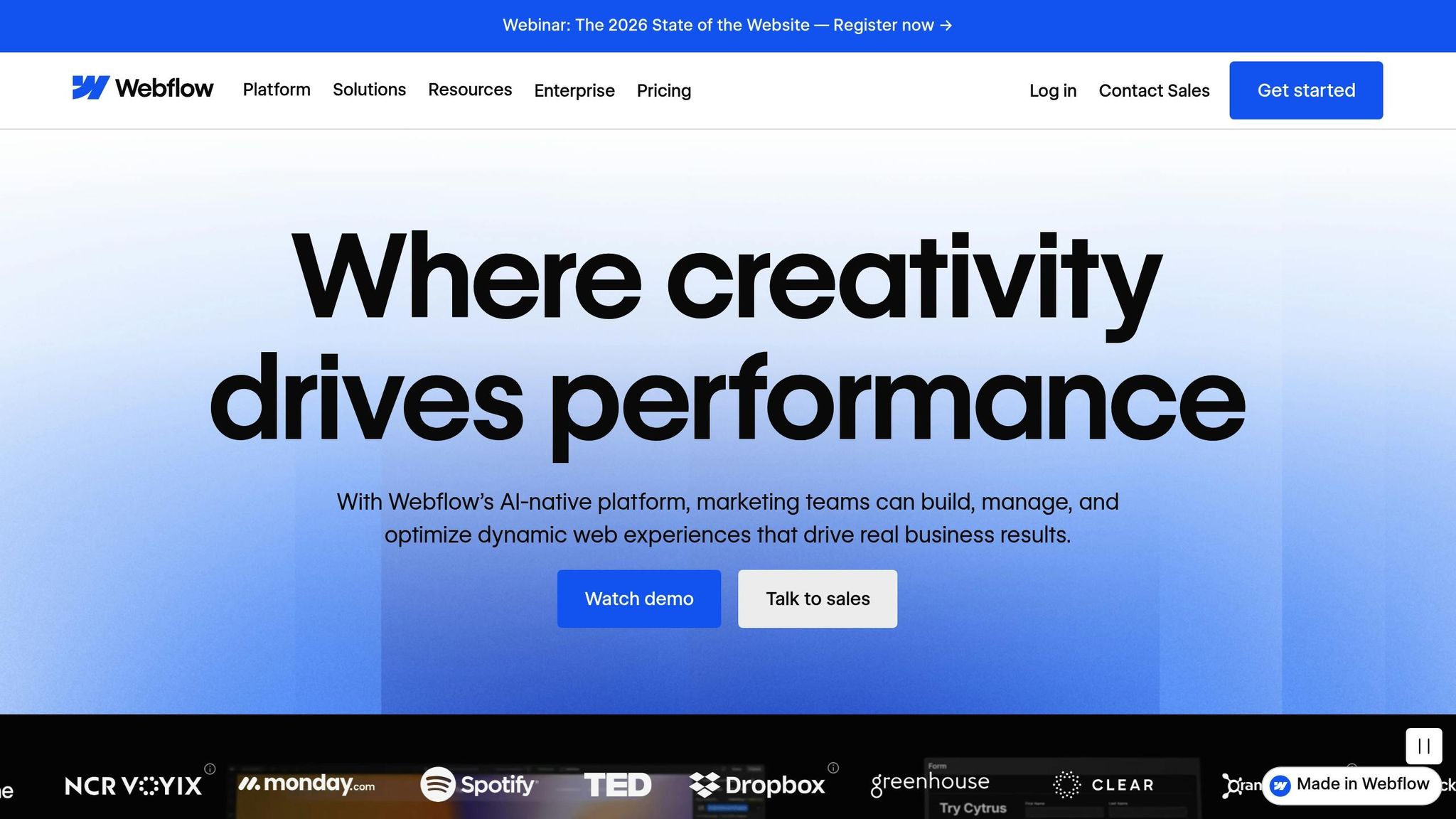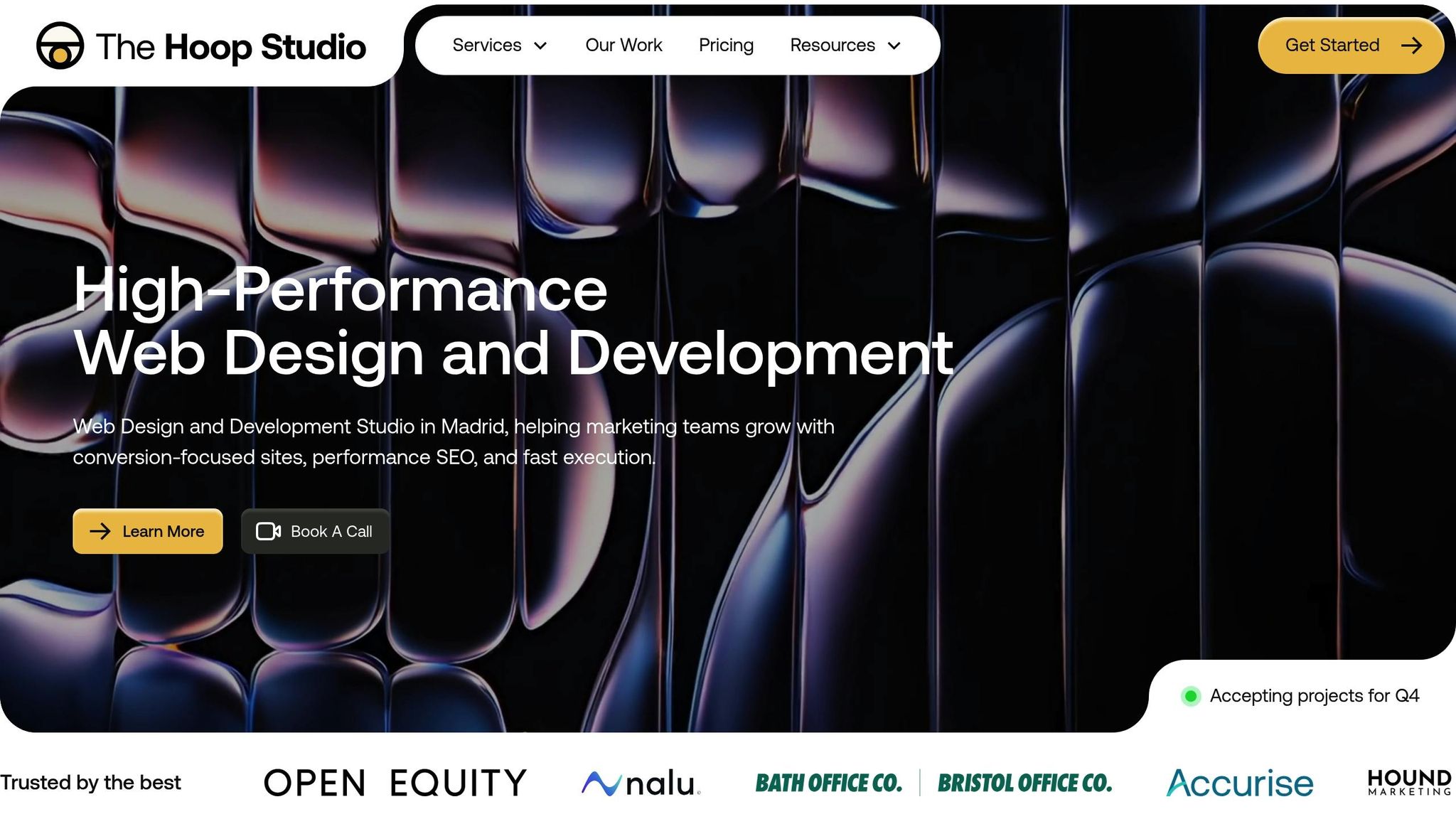Insights
Performance
Copy Link

Enhance your website's speed with actionable strategies for backend and frontend optimization, ensuring better user experience and improved search rankings.
Website speed directly affects user experience, sales, and search rankings. A slow site can drive users away, hurt conversions, and lower your visibility on Google. Here's how to make your site faster:
Speed isn't just a technical detail - it's a business priority. Follow these steps to ensure your site loads fast and keeps users engaged.
The backend is the backbone of your website’s performance. It’s where server-side components come into play, directly affecting how fast and stable your site feels to users. Setting up a solid backend means making smart choices about hosting and server optimization.
Your hosting provider has a direct impact on how fast your site loads. To ensure top performance, look for hardware like AMD EPYC™ CPUs and NVMe SSDs, and pick a server location close to your audience. For example, if most of your users are on the East Coast, a server in Virginia can significantly cut response times.
Aim to keep your Time to First Byte (TTFB) under 350–400 ms. If it creeps over 700–800 ms, user experience will take a hit. As your traffic grows, consider upgrading from shared hosting to more robust options like VPS, managed VPS, or dedicated CPU servers to prevent slowdowns and bottlenecks.
Optimizing your database is a must, especially for content-heavy websites. Regularly clean up data, use indexing, and refine your queries to minimize delays.
Server-side caching is another key strategy. Tools like LiteSpeed Cache, SuperCacher, or NGINX proxy caching store frequently accessed content in memory. This reduces the need for repetitive processing, speeding up load times for returning visitors.
Using modern software stacks can also make a big difference. Pairing LiteSpeed or NGINX with Ultrafast PHP/PHP-FPM and a finely tuned MySQL setup ensures your server can handle requests efficiently, even during peak traffic.
CDNs are game-changers for reducing latency. By caching static assets (like images or scripts) on servers closer to your users, they deliver content faster. For example, a CDN server in Florida can serve Miami-based visitors quicker than a distant origin server.
Providers like Cloudflare and Fastly not only speed up delivery but also protect your site by filtering out malicious traffic and mitigating DDoS attacks. Setting up a CDN is often as simple as tweaking your DNS settings or installing a plugin, making it an easy yet powerful upgrade for your backend infrastructure.
Backend optimization focuses on server-side performance, but frontend optimization targets the visible elements of your site. Improving frontend performance can make a website feel faster to users since they judge speed based on how quickly content appears on their screens. Below, you'll find practical techniques to enhance frontend performance and complement backend improvements.
Images often make up a significant portion of a webpage's size, so optimizing them is crucial for faster loading times. The goal is to maintain high visual quality while reducing file sizes.
Tools like TinyPNG and ImageOptim can compress images with minimal quality loss, significantly shrinking file sizes. For bulk optimization, Squoosh by Google allows you to compare compression settings side-by-side to find the best balance between quality and size.
Switching to modern image formats like WebP and AVIF can further reduce file sizes compared to traditional JPEG and PNG files. WebP generally produces smaller files than JPEG at similar quality levels, while AVIF offers even better compression. However, since not all browsers fully support these formats, you should use the <picture> element to provide fallbacks for older browsers.
Responsive images are another essential tool. By using the srcset attribute, you can ensure that devices download appropriately sized images, which is especially helpful for mobile users. Additionally, enabling lazy loading by adding loading="lazy" to your image tags delays the loading of images until they are about to appear on the screen, speeding up initial page rendering.
These strategies, when paired with backend optimizations, can dramatically improve load times.
Efficient code is key to faster page loads and smoother execution. Building on server-side improvements, frontend code optimization ensures a seamless user experience.
Minification is an essential step that removes unnecessary spaces, comments, and formatting from CSS and JavaScript files without altering functionality. Tools like UglifyJS and Terser handle JavaScript minification, while CSSNano compresses stylesheets by eliminating redundant rules and optimizing values.
For JavaScript-heavy sites, tree-shaking can reduce bundle sizes by removing unused code. This is particularly useful if you're using a large library but only need a few specific functions.
Another effective technique is critical CSS, which involves identifying and inlining the styles needed for above-the-fold content directly in the HTML. This approach ensures users see styled content immediately while the rest of the CSS loads in the background, minimizing render-blocking delays.
Every file your webpage requests adds load time, especially on slower connections. Reducing these requests can significantly improve performance.
File concatenation combines multiple CSS or JavaScript files into a single file, cutting down the number of HTTP requests. Similarly, merging CSS files can streamline resource loading.
For images, CSS sprites combine multiple small graphics (like icons) into a single file, using CSS positioning to display the appropriate part of the image. While modern techniques often favor SVGs or icon fonts, sprites remain useful for decorative images and can reduce the number of requests.
Prioritizing above-the-fold content ensures users see the most important parts of your page first. Techniques like inlining critical CSS, deferring non-essential JavaScript with the defer attribute, and loading below-the-fold resources after the initial render can improve perceived speed, even if the total load time stays the same.
Tools like Webpack and Parcel simplify resource bundling by automatically combining files, removing unused code, and applying compression. These tools streamline asset delivery, reducing the total number of requests and improving overall efficiency.

Webflow comes equipped with features and customization options designed to enhance website performance. Knowing how to make the most of these tools can mean the difference between a site that drags and one that loads swiftly.
Webflow takes care of several performance enhancements automatically, saving you the hassle of manual setups. For instance, it compresses images and converts them to modern formats like WebP when supported, resulting in smaller file sizes compared to traditional JPEGs.
The platform also incorporates lazy loading for images, including those within the CMS. This feature delays the loading of images until they're about to appear on the screen, improving the initial page load speed.
Another automatic perk? Webflow minifies your CSS and JavaScript every time you publish, ensuring your code is as lightweight as possible.
Webflow’s global Content Delivery Network (CDN) is built right into the platform, which means your assets are distributed across multiple servers for faster delivery.
For sites that rely heavily on CMS content, Webflow uses collection page caching. This stores pre-rendered versions of dynamic pages like blog posts or product pages. The result? Faster load times since the server doesn’t have to rebuild these pages for each visitor. And when you update your content, the cache refreshes automatically, maintaining both speed and accuracy.
In addition to Webflow's built-in features, smart use of custom code can further enhance performance. However, poorly written code can easily slow your site down, so it’s essential to optimize any custom scripts.
defer attribute for non-critical JavaScript to prevent it from blocking the initial page render. For analytics tools like Google Analytics or Facebook Pixel, load these scripts asynchronously using Google Tag Manager. This ensures they don't interfere with the main content's loading.
font-display: swap CSS property. This allows browsers to display fallback fonts immediately while custom fonts load in the background, avoiding any flash of invisible text.
fonts.googleapis.com in your site’s head section can speed up font loading by establishing an early connection to the font server.
Keeping your Webflow site optimized requires consistent monitoring, especially as you add new content or features. Over time, changes like increased content or new integrations can impact performance.
Use tools like Google PageSpeed Insights to routinely audit your site's Core Web Vitals. By documenting and tracking these scores, you can identify and address any performance dips as your site evolves.
Regularly clean out unused media files and review third-party integrations to ensure they aren’t dragging down performance.
For sites with extensive CMS content, large text blocks with heavy formatting can slow down page generation. Breaking long-form content into smaller sections and using rich text elements sparingly helps prevent bloated HTML.
Finally, evaluate the impact of custom code on your site's speed. Use browser developer tools to compare load times with and without custom scripts. Automated monitoring tools like Google Search Console can also alert you to any drops in Core Web Vitals scores, allowing you to fix issues before they affect user experience or search rankings.
After implementing backend and frontend improvements, the next step is measuring and monitoring your website's performance. This process ensures your efforts are working and helps maintain speed over time. By identifying bottlenecks and tracking changes, you create a feedback loop that keeps your site running smoothly.
Google PageSpeed Insights is a go-to tool for analyzing website performance. Alongside GTmetrix and WebPageTest, it provides unique insights into how your site performs. These tools evaluate real user experiences, simulate different network conditions, and offer technical breakdowns to pinpoint issues.
When using PageSpeed Insights, start with the Field Data section. This reflects actual user experiences and highlights areas needing attention. The Lab Data section, on the other hand, uses controlled conditions to identify specific technical issues. Don’t miss the Opportunities section, which suggests improvements and estimates the time savings they could bring.
GTmetrix combines Google Lighthouse data with additional metrics for a deeper analysis. Its detailed waterfall charts show how each resource loads, making it easier to spot slow-loading elements. You can also test from various geographic locations, which is especially useful for businesses with customers across the United States.
WebPageTest takes performance testing further with features like multi-step transactions and connection throttling. It’s excellent for simulating slower internet speeds, giving you a better sense of how users with limited bandwidth experience your site. The filmstrip view visually demonstrates how your page loads, highlighting whether key content appears quickly enough.
For ongoing monitoring, set up automated testing schedules. GTmetrix Pro allows daily or weekly tests, while WebPageTest provides API access for more customized solutions.
Google’s Core Web Vitals are key metrics for both search rankings and user experience. These include:
Google Search Console is your best source for Core Web Vitals data since it reflects real user experiences. Its Core Web Vitals report identifies pages that need improvement and tracks progress over time. Unlike synthetic tools, this data comes directly from Chrome users visiting your site.
To dive deeper, use the Chrome User Experience Report (CrUX) via BigQuery or its API. This data provides insights into how different user segments experience your site’s performance.
Integrating Google Analytics 4 with Core Web Vitals tracking can link performance metrics to business outcomes like conversion and bounce rates. Custom reports can highlight how page speed affects your specific goals.
For real-time tracking, implement the web-vitals JavaScript library. This lightweight tool measures Core Web Vitals for actual users and sends the data to your analytics platform. It offers detailed insights, including percentile ranges and device-specific performance.
After identifying performance issues, continuous optimization is crucial. Conduct monthly audits of key pages, set performance budgets (e.g., hero images ≤150KB, mobile pages <1MB), and use A/B testing to validate changes. Tools like Google Optimize can help you measure how speed improvements influence user behavior and conversions. Collect user feedback through simple widgets to uncover performance problems that automated tools might miss.
Competitive benchmarking is another valuable tactic. Regularly test competitor websites using the same tools and metrics. This can highlight areas where you can outperform others by improving speed and performance.
Set up automated alerts to catch performance drops early. Tools like Google Search Console or third-party monitoring services can notify you when Core Web Vitals scores fall below acceptable levels or page load times increase. Early detection helps you address issues before they affect rankings or user satisfaction.
Finally, maintain a performance log to document changes, results, and lessons learned. This record will guide future optimization efforts and help avoid repeating mistakes.
Improving website speed isn’t just a one-time task - it’s an ongoing effort that has a direct impact on your business. The techniques outlined here work together to create faster, more efficient websites that keep both users and search engines happy.
A faster website benefits your entire digital presence. Quick-loading pages reduce bounce rates, encourage visitors to stay longer, and increase the chances of them taking action - whether that’s making a purchase, signing up for a service, or filling out a form.
In the U.S., where users expect instant results, even minor delays can hurt your brand’s reputation. A fast website not only enhances user experience but also conveys trust and professionalism, which are critical for business success.
Here’s how you can turn these insights into practical strategies for maintaining speed over time:
By combining these steps, you can maintain a consistently fast and reliable website.

The Hoop Studio specializes in creating fast, conversion-focused websites that merge speed optimization with smart marketing strategies.
Their Growth Website Build service includes everything you need for a high-performing site: SEO-optimized structure, analytics integration, and mobile-first design. For ongoing support, their Ongoing Web Partner program offers monthly services like performance audits, conversion updates, and SEO monitoring to keep your site running smoothly.
Whether you’re starting from scratch or improving your current website, working with professionals ensures these strategies are implemented effectively, helping your site perform at its best for the long haul.
If you suspect your hosting provider might be slowing down your website, start by checking your server's response time. One key metric to look at is Time to First Byte (TTFB) - if it takes longer than 800 milliseconds, it could point to hosting-related issues. Tools like Google PageSpeed Insights or GTmetrix can help you evaluate your site's performance and spot any bottlenecks.
Consistently slow load times, frequent downtime, or crashes are red flags that your hosting plan may no longer meet your needs. Shared hosting, for example, often divides resources among many users, which can lead to performance issues. Upgrading to a VPS, dedicated server, or cloud hosting can provide better speed, reliability, and scalability as your site grows.
Core Web Vitals are three performance metrics that gauge how users interact with your website. These include:
These metrics matter because Google incorporates them into its ranking algorithm. A site that loads quickly, responds efficiently, and maintains a stable layout not only enhances user satisfaction but also has a better chance of ranking higher in search results. Focusing on these metrics is key to improving site performance, retaining visitors, and boosting SEO.
To keep tabs on your website's speed and make improvements, tools like Google PageSpeed Insights and GTmetrix are incredibly useful.
Google PageSpeed Insights evaluates your site's performance using Google's Core Web Vitals. It provides specific recommendations to enhance the user experience, giving you a clear idea of how Google views your site's speed and overall performance.
On the other hand, GTmetrix dives deeper by simulating real-world conditions, such as different browsers and devices. Its Waterfall Chart is especially handy for identifying performance bottlenecks like slow-loading scripts or oversized images. Plus, GTmetrix lets you monitor your site's performance over time, helping you track progress and identify recurring issues.
For the most comprehensive results, consider using both tools together. Google PageSpeed Insights helps you align with Google's standards, while GTmetrix offers a detailed technical breakdown to fine-tune your site's performance.